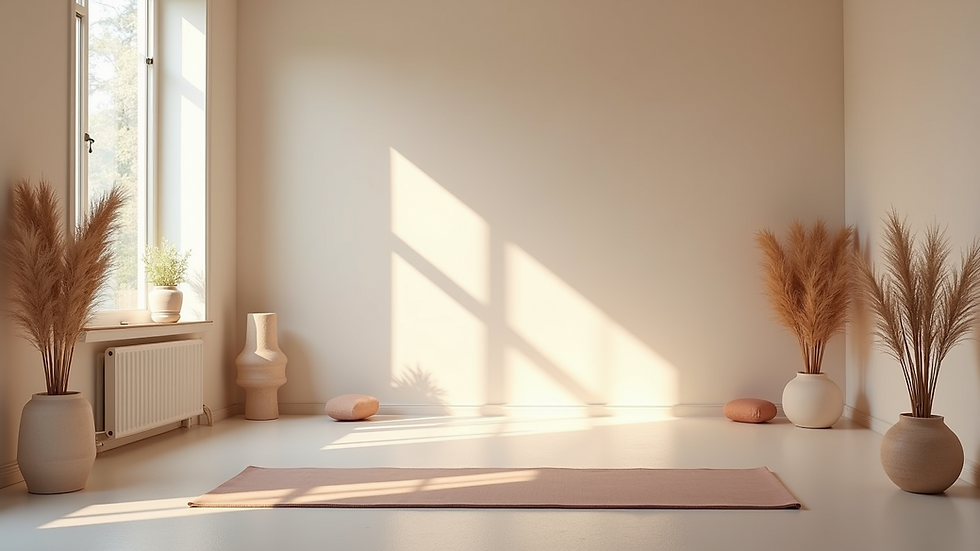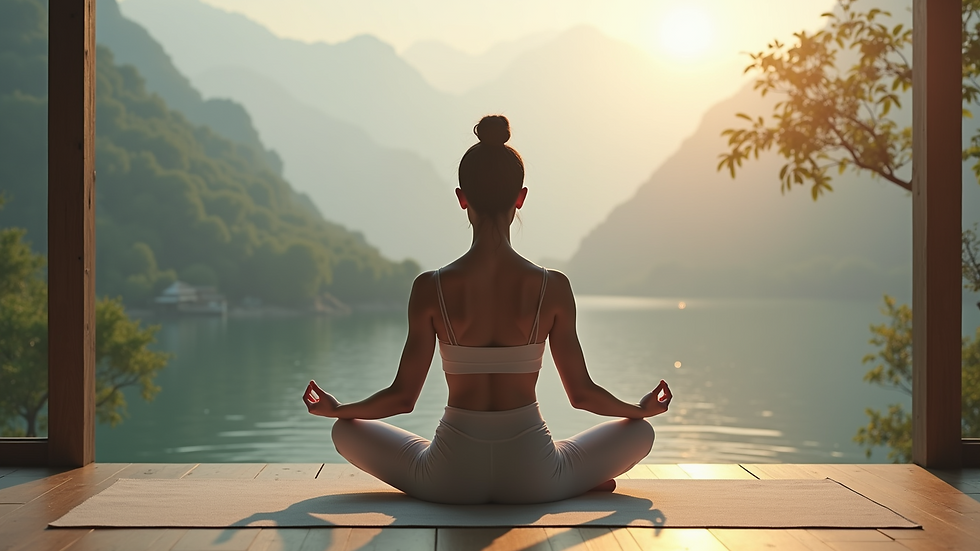Yin Yoga vs Restorative Yoga: Understanding the Key Differences
- Rock Collage

- Sep 19
- 4 min read
Yoga has gained widespread popularity as a path to physical, mental, and emotional well-being. Among the various styles, Yin Yoga and Restorative Yoga often get confused due to their calm and gentle nature. Yet, these practices serve different purposes, each offering unique benefits. This post will clarify the key differences between Yin Yoga and Restorative Yoga, helping you determine which practice is the best fit for your needs.

What is Yin Yoga?
Yin Yoga is a slow-paced style of yoga that focuses on stretching and lengthening the connective tissues in the body, including ligaments, tendons, and fascia. Practitioners hold poses for an extended period—usually between three to five minutes—which allows for deep relaxation and a meditative state.
Yin Yoga aims to enhance flexibility, promoting the flow of energy throughout the body. By targeting deeper connective tissues, individuals can release tension and improve overall mobility. This practice is typically performed in a quiet space, creating an environment that fosters mindfulness and introspection.
Rooted in traditional Chinese medicine, Yin Yoga works with the energy pathways known as meridians. For instance, poses such as the Caterpillar Pose or Child’s Pose can stimulate specific meridians, which may help balance energy and promote healing. Research shows that practices focusing on flexibility can enhance physical performance and recovery in athletes, making Yin Yoga particularly beneficial for those who lead an active lifestyle.
What is Restorative Yoga?
Restorative Yoga is designed to promote relaxation and healing through gentle, supported poses. Utilizing props like blankets, bolsters, and blocks allows the body to relax completely in various postures.
In Restorative Yoga, poses are typically held for longer periods—often ranging from five to twenty minutes—creating a sense of comfort and ease. This practice serves to release tension and stress. For instance, the Supported Child’s Pose and Reclined Bound Angle Pose are excellent for cultivating relaxation and can provide profound help to those experiencing chronic pain or recovering from injuries.
Restorative Yoga emphasizes breath and mindfulness, enabling practitioners to connect with their bodies and cultivate tranquility. A study found that practicing restorative yoga can reduce cortisol levels, significantly lowering stress and anxiety.
Key Differences Between Yin Yoga and Restorative Yoga

1. Purpose and Focus
The main difference between Yin Yoga and Restorative Yoga lies in their purpose. Yin Yoga targets the deeper connective tissues to enhance flexibility, while Restorative Yoga focuses on relaxation and stress relief.
In Yin Yoga, the emphasis is on stretching and lengthening the body. For example, stretches like the Dragon Pose can increase flexibility in the hips. On the other hand, Restorative Yoga focuses on comfort and support, prioritizing gentle poses that promote relaxation.
2. Poses and Duration
Another significant difference is the type of poses used and the duration for which they are held.
Yin Yoga poses can be more challenging and require active engagement. For instance, in Half Butterfly Pose, practitioners hold the stretch for up to five minutes.
Restorative Yoga poses, however, are softer and supported by props. They are often held for much longer durations, occasionally up to twenty minutes, which allows for complete relaxation.
3. Energy Flow vs. Relaxation
Yin Yoga aims to stimulate energy flow by targeting specific meridians and promoting balance. Practitioners often experience a palpable energy moving through them, resulting in a rejuvenated feeling.
Conversely, Restorative Yoga focuses on achieving deep relaxation. The use of props enables the body to release tension, leading to a calm and peaceful state.
4. Mental and Emotional Benefits
Both styles provide mental and emotional benefits, but in different ways.
Yin Yoga fosters mindfulness and introspection as practitioners sit with their thoughts and feelings during poses. This can help increase self-awareness.
Restorative Yoga promotes relaxation and stress relief, helping to calm the mind and reduce anxiety. Its gentle approach enables individuals to let go of worries and cultivate a sense of inner peace.
5. Ideal Practitioners
While both types of yoga are beneficial for many individuals, they may attract different practitioners based on their specific needs.
Yin Yoga is ideal for those seeking to enhance flexibility, release tension, and explore their emotional well-being. This style may particularly appeal to athletes seeking to deepen their practice.
Restorative Yoga is perfect for anyone pursuing relaxation, recovery from injury, or stress relief. It is a great choice for those feeling overwhelmed or fatigued.
When to Choose Yin Yoga
Consider adding Yin Yoga to your routine if you want to:
Enhance flexibility and mobility.
Release deep tension within your body.
Explore emotional and mental states through mindfulness.
Complement an active physical practice.
If you frequently feel tight or stiff and want to explore your emotional landscape, Yin Yoga might resonate with you.
When to Choose Restorative Yoga
Opt for Restorative Yoga if you are aiming to:
Redefine your stress and anxiety levels.
Foster relaxation and healing.
Recover from injury or chronic pain.
Discover inner peace and tranquility.
If you find yourself overwhelmed or fatigued and need an escape from daily life’s demands, Restorative Yoga could be the answer.
Combining Yin and Restorative Yoga
Although Yin Yoga and Restorative Yoga have distinct characteristics, they can complement each other beautifully.
Incorporating both practices into your routine provides a comprehensive approach to physical, mental, and emotional well-being. For example, practice Yin Yoga on days when focusing on flexibility and energy flow feels right. On other days, turn to Restorative Yoga for unwinding and recharging.
By grasping the key differences between Yin Yoga and Restorative Yoga, you can make informed decisions about your practice, tailoring it to meet your individual needs.
Summary Thoughts
To summarize, Yin Yoga and Restorative Yoga are two distinct styles of yoga that offer unique benefits. Yin Yoga emphasizes stretching and lengthening connective tissues, while Restorative Yoga focuses on relaxation and healing through gentle, supported poses.
Understanding the differences between these practices allows you to select the one that best aligns with your goals and needs. Regardless of which you choose, both practices can significantly enhance your overall well-being and contribute to a richer, more balanced life.








Comments